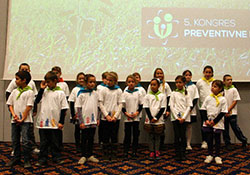National congress focuses on disease prevention as key to strengthening public health in Slovenia

WHO/Marijan Ivanusa
The 5th Congress on Preventive Medicine, held in Portorož on 15–17 November 2012, brought together 250 public health professionals to focus on four key topics:
- society and health
- promotion and health protection
- environment and health
- communicable diseases and immunization.
In addition to enhancing the cohesion, professionalism and visibility of public health in Slovenia, the participants' input in these areas is seen as crucial for the ongoing process of reshaping public health structures in Slovenia.
Eminent speakers
The Congress was organized by the Society for Preventive Medicine and opened by the Society's President, Dr Alenka Kraigher from the Slovenian Medical Association, who spoke on public health as an opportunity for a changing society. Dr Mojca Gobec, Director General of the Public Health Directorate at the Ministry of Health, also addressed the participants during the opening session.
The first key-note speaker, Dr Božidar Voljč, the first Minister of Health in independent Slovenia, and former member of the Standing Committee of the WHO Regional Committee for Europe (SCRC) and the WHO Executive Board, pointed out some of the challenges of today's changing society, including population ageing, declining solidarity and equity as well as the unutilized potential of communities.
Dr Gauden Galea, Director of WHO/Europe's Division of Noncommunicable Diseases (NCDs) and Health Promotion, presented selected key epidemiological data showing evidence of rapid change in the NCD epidemic. He linked the topic and related measures to the European health policy Health 2020 and the European Action Plan for Strengthening Public Health Capacities and Services. Dr Galea’s presentation also set the scene for stepping up work in the area of NCDs in Slovenia by suggesting four key areas of action:
- planning and oversight
- building healthy public policy
- healthy settings
- secondary prevention.



